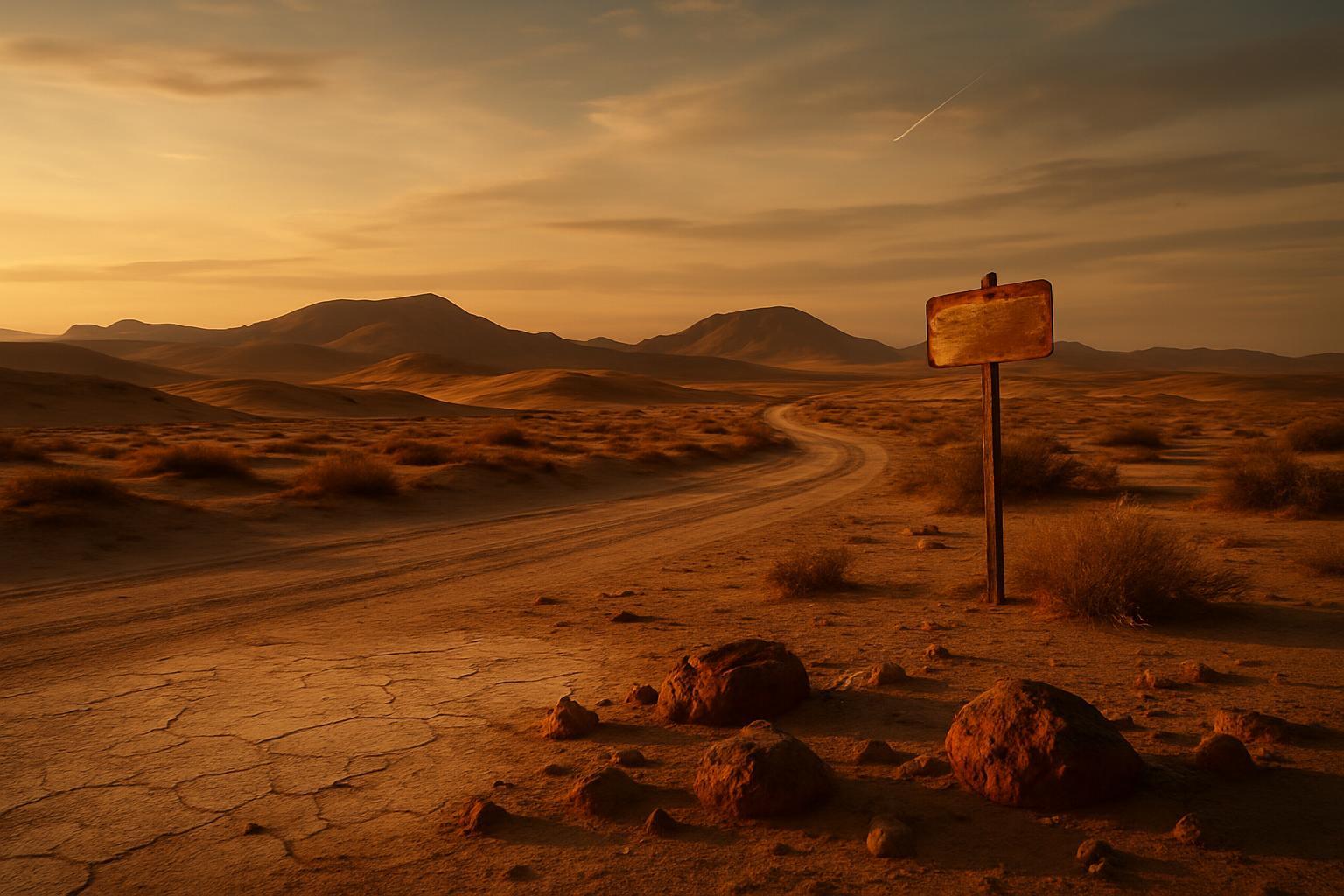Deep in northern Mexico, a sunbaked stretch of land whispers with tales of strange energy and mysterious silence. Some call it the “Mexican Bermuda Triangle.” Others know it as the Zone of Silence. Here, radio signals reportedly vanish, compasses spin, and rumors of the unexplained find fertile ground. But what happens when natural oddities mix with human fear and folklore? Let’s explore what really makes the Silent Zone one of the world’s most talked-about desert enigmas.
Locating the Silent Zone: A Patch of Desert
The Silent Zone, or La Zona del Silencio, lies in the Mapimí desert—a vast, arid expanse spanning parts of Durango, Coahuila, and Chihuahua. This remote region sits about 400 miles south of El Paso, Texas. The area covers over 1,500 square miles, marked by rolling dunes, salt flats, and rugged scrubland.
Access is not easy. Most visitors travel along rough, rutted dirt roads. A few small ranches break the landscape, but otherwise, you’ll find yourself a long way from towns and cities. The Mapimí Biosphere Reserve now protects much of the land, offering rare glimpses of desert wildlife amid the silence.
Why Is It Called the Zone of Silence?
Stories say radios stop working. Compasses lose their way. Electronic devices falter. The air seems to thicken, and the outside world drops away. For locals, these experiences became part of a legend. Journalists and explorers arrived, hungry for answers and eager to connect it to other mystery spots—like the Bermuda Triangle in the Atlantic. Over time, the term “Zone of Silence” stuck, capturing the eerie atmosphere travelers often claim to feel.
The Origins of the Mystery
The legend begins in the 1970s, although tales of odd happenings stretch back much earlier. The Zone first drew wide attention after a very real, very unusual event: a NASA test missile went off course on July 11, 1970. Instead of its planned impact zone in New Mexico, the Athena rocket crashed deep inside the desert near the Mapimí region.
This accident stunned both American and Mexican authorities. The U.S. government swiftly sent a recovery team. Engineers built an access road, creating a path straight through the barren land to retrieve classified equipment. Locals noticed the sudden foreign interest—and soon began sharing stories of their own strange experiences.
The NASA Missile Incident
The Athena rocket’s crash helped kickstart Silent Zone myths. As recovery teams combed the desert, journalists picked up on the idea that extraordinary things must lurk here. Locals reported blackened soil around the site, which scientists later said was likely from burning rocket fuel and impact.
Soon, rumors tied the American presence to secret knowledge of the desert. The belief spread: if NASA was so keen to investigate, then perhaps the site held cosmic secrets. Was this just a case of government caution and cold war secrecy? Or was there more to it?
What Happens Inside the Zone?
Visitors to the Silent Zone often report several odd occurrences, which give the place its reputation. However, not all stories hold up under scrutiny. Here are the most common claims and what science has to say about them:
Radio Silence and Lost Signals
Many believe radio waves refuse to travel in parts of the zone. Hikers say their walkie-talkies remain stubbornly static, even as the desert stretches open before them. Local tour guides play up the effect, sometimes suggesting the area is a natural dead zone, much like the Bermuda Triangle.
Scientific studies, however, don’t fully support this. While radio interference is real in some spots, it is not unique to this region. The area’s mineral-rich soil and magnetic rocks can cause problems, as can the simple isolation—there are far fewer radio towers nearby. The low moisture and extreme heat also affect how sound and waves travel. But radios work on the edge of the zone, and failures are rarely consistent across all devices.
Magnetic Effects and Compass Malfunctions
Compasses have a tough time in the Zone of Silence, at least according to some travelers. Hand-held devices may swing unpredictably, leaving users confused about true north. The culprit is most often iron-rich rocks scattered across the land. Magnetite and other minerals occur naturally here, and these can create minor disturbances. Yet, serious magnetic anomalies are rare. Navigating the desert is hard, but it’s more likely due to endless, similar-looking terrain than supernatural forces.
Strange Creatures and Unique Wildlife
Folklore brims with tales of odd animals—reptiles with impossible colors, plants that heal wounds or even giant moths flitting through the midnight sky. While scientists treasure the region for its biodiversity, most creatures here are just well-adapted desert dwellers. The Mapimí Biosphere Reserve hosts species like the desert tortoise, kit fox, and burrowing owl. Some plants here do show remarkable endurance, but none break the laws of biology. Instead, their survival hints at the harshness and uniqueness of this environment, not extraterrestrial visitors.
Fireballs and Unexplained Lights
Throughout the decades, reports have surfaced describing fiery streaks across the sky. Locals love to tell about strange orbs hovering over the salt flats at night, or bright flashes that vanish in seconds. Given the high number of meteorites and the clarity of the desert sky, it’s not surprising. Meteor showers dazzle viewers, and unexplained lights are often linked to atmospheric conditions or distant thunderstorms. Still, these stories add fuel to the zone’s reputation as a place where rules seem looser, and wonder thrives.
Alien Encounters: Folklore or Fact?
No story about a mysterious zone would be complete without its cast of unexplained visitors. Since the 1970s, locals and tourists have spun tales about strange entities wandering the sand. Reports range from ghostly figures dressed in odd clothing to overt encounters with supposed “Nordic” aliens—tall, pale beings who communicate silently or offer cryptic warnings.
In one famous account, a rancher told of meeting three blonde, fair-skinned strangers after his truck broke down. The trio, speaking perfect Spanish, helped fix the vehicle before disappearing without a trace. Other stories describe lost travelers being led to safety by eerie, elusive figures. Despite the allure, there is zero scientific evidence for extraterrestrials visiting Mapimí—or anywhere else on Earth. The desert, wide and unforgiving, is a natural stage for the mind to craft stories, especially under the spell of empty silence.
Scientific Interest and Research
Despite the legends, real science continues here. Mexican researchers and international ecologists study the Mapimí Biosphere Reserve, because the harsh environment creates challenges for plants and animals. Every surviving species boasts special adaptations, from water-hoarding roots to nocturnal habits that dodge the furnace-like sun.
The reserve is a living laboratory, helping us understand evolution, desertification, and climate. NASA’s interest in the area, after the missile crash, was about recovery and safety, not search for otherworldly secrets. Yet, this initial focus pushed the region into the spotlight, echoing through every tale told since.
An Ecosystem Worth Protecting
The biosphere supports hundreds of species, many of them threatened. Pronghorn antelope, gopher tortoises, and rare desert plants find sanctuary here. Conservationists work alongside local communities to monitor wildlife and restore habitats. The reserve is also home to research stations, where students and scientists collect data on everything from soil structure to migratory bird populations. This is the true wonder of the zone: that life, against all odds, flourishes in a place so many describe as lifeless.
Why Do Legends Thrive Here?
The Zone of Silence captivates our imagination for two main reasons. First, the desert is remote and unforgiving—a natural place to inspire awe, caution, and a sense of the unknown. Few people live here, and fewer still travel far into its heart. When odd things happen, they are less likely to be explained, giving rumors room to grow. Second, the landscape itself supports the myths. The earth is full of iron, and storms wash up unusual rocks. Real incidents, like the NASA missile and meteorite falls, fuel a sense of cosmic attention. When fact and legend overlap, the line between them blurs.
The Power of the Human Mind
Stories grow when they pass from person to person. Each telling shapes the tale further. Psychologists call this “collective memory.” Once a story takes hold—especially one filled with wonder or fear—it becomes part of a community’s fabric. The Zone of Silence has become a magnet for such stories, drawing seekers, skeptics, and believers alike. When you step into the open desert and feel that numbing isolation, your mind does the rest.
Visiting the Zone: What to Expect
Adventurous tourists now travel to the Silent Zone. Some come for the mysteries, others to witness the stark beauty. Organized tours leave from nearby towns, often including visits to the crash site, local caves, and the Mapimí research stations. Guides share the legends as you roll across sunbleached salt pans, pausing to examine meteorite fragments or ancient fossils.
- Roads: Dirt and gravel, often rough and muddy after rain.
- Cell Service: Spotty and unreliable. Bring a satellite phone if safety is a concern.
- Wildlife: Bring binoculars for a chance to spot the rare kit fox, burrowing owl, or tarantula.
- Preparedness: Carry plenty of water, sun protection, and basic first aid in case of emergencies.
Because the area is remote, traveling with a local guide is safest. Ranchers and scientists are often willing to share their experiences, offering both practical advice and new stories for you to consider.
Respect for the Land and Its People
While searching for the unexplained, remember that the Silent Zone is home to real communities. Ranchers rely on hard work to survive in this challenging climate. Conservation and research efforts help keep the ecosystem healthy. If you visit, tread lightly and honor the privacy of those who live here. Respect protected areas and avoid leaving trash or damage behind. The real magic of the desert is in its quiet—listen to it, and let your imagination roam.
Theories Behind the Zone’s Mysteries
So, why do so many odd things seem to happen here? A few scientific explanations hold weight:
- High Levels of Meteoric Iron: The desert is littered with meteorites, which means plenty of natural metals that can affect compasses and sometimes radio frequencies.
- Mineral-Rich Soil: Iron, uranium, and magnesium-rich rocks naturally alter magnetic readings in some locations.
- Geography and Isolation: Large distances from populated areas or radio towers mean naturally weaker signals and more “dead zones.”
- Atmospheric Conditions: Extreme temperatures and humidity shifts affect both sound and electronic signals, sometimes creating strange effects.
Though none of these factors alone fully explain the region’s reputation, together they paint a picture of a unique environment where unusual things can, and do, happen—without needing extraterrestrial help.
Comparisons to Other Mystery Zones
People love to connect the Zone of Silence with other famous places like the Bermuda Triangle or the Devil’s Sea in Japan. All share three things in common: remote locations, reports of navigation trouble, and centuries of tall tales. The Bermuda Triangle’s infamy is rooted in lost ships and planes; in Mapimí, it’s about failed radios and wandering magnetic needles. Both places reflect our drive to find patterns in random events. When isolated problems occur, they become evidence for the extraordinary—though the truth is almost always more Earth-bound.
How the Zone Became Part of Pop Culture
Over time, stories from the Zone of Silence have found their way into books, documentaries, and online forums. Paranormal researchers rank it alongside the world’s most mysterious places. The zone appears in Spanish soap operas, Mexico’s popular science magazines, and even as a setting in a handful of horror films.
For those living near the zone, tourism offers both opportunity and challenge. Travelers arrive looking for the unexplained, and locals offer tours and advice. However, some scientists fear the legends overshadow real research. The emphasis on aliens and lost signals can distract from urgent conservation work and the fragile health of desert ecosystems.
Still, curiosity has benefits. The stories that swirl around the Silent Zone have spurred real investment in studying this isolated patch of earth. Without the myths, much of the scientific attention might not exist—not to mention the steady trickle of adventurous visitors itching to experience the zone’s famous hush in person.
Separating Facts from Folklore
With every passed-down tale, the Silent Zone’s reputation grows. But after decades of study, a clear picture forms. Natural oddities abound here, but nothing truly defies nature’s rules. Radio and magnetic mishaps can be traced to the land’s geology. Meteor showers explain streaks and fireballs. Unique wildlife survives not through magic, but through generations of adaptation.
That doesn’t make the place any less special. In fact, the real story—one written by geology, biology, and resolved curiosity—is just as captivating. The mix of legend and truth lures us, daring us to look deeper. The desert offers silence and strangeness, but the mystery lies in what your mind fills in between the facts.
Standing in the heart of the Silent Zone, you’ll feel small. The wind hushes, the sky stretches blue forever, and stories echo from every rock and salt pan. Whether you come seeking answers or just wide-open wonder, this desert reminds you there’s still room on Earth for mystery—whether in truth or in legend.



